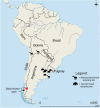A mitogenomic timetree for Darwin's enigmatic South American mammal Macrauchenia patachonica
- PMID: 28654082
- PMCID: PMC5490259
- DOI: 10.1038/ncomms15951
A mitogenomic timetree for Darwin's enigmatic South American mammal Macrauchenia patachonica
Abstract
The unusual mix of morphological traits displayed by extinct South American native ungulates (SANUs) confounded both Charles Darwin, who first discovered them, and Richard Owen, who tried to resolve their relationships. Here we report an almost complete mitochondrial genome for the litoptern Macrauchenia. Our dated phylogenetic tree places Macrauchenia as sister to Perissodactyla, but close to the radiation of major lineages within Laurasiatheria. This position is consistent with a divergence estimate of ∼66 Ma (95% credibility interval, 56.64-77.83 Ma) obtained for the split between Macrauchenia and other Panperissodactyla. Combined with their morphological distinctiveness, this evidence supports the positioning of Litopterna (possibly in company with other SANU groups) as a separate order within Laurasiatheria. We also show that, when using strict criteria, extinct taxa marked by deep divergence times and a lack of close living relatives may still be amenable to palaeogenomic analysis through iterative mapping against more distant relatives.
Conflict of interest statement
The authors declare no competing financial interests.
Figures



Similar articles
-
Ancient proteins resolve the evolutionary history of Darwin's South American ungulates.Nature. 2015 Jun 4;522(7554):81-4. doi: 10.1038/nature14249. Epub 2015 Mar 18. Nature. 2015. PMID: 25799987
-
Pleistocene South American native ungulates (Notoungulata and Litopterna) of the historical Roth collections in Switzerland, from the Pampean Region of Argentina.Swiss J Palaeontol. 2023;142(1):28. doi: 10.1186/s13358-023-00291-5. Epub 2023 Oct 6. Swiss J Palaeontol. 2023. PMID: 37810207 Free PMC article.
-
Phylogenetic tree of Litopterna and Perissodactyla indicates a complex early history of hoofed mammals.Sci Rep. 2020 Aug 6;10(1):13280. doi: 10.1038/s41598-020-70287-5. Sci Rep. 2020. PMID: 32764723 Free PMC article.
-
Phylogenomics and the Genetic Architecture of the Placental Mammal Radiation.Annu Rev Anim Biosci. 2021 Feb 16;9:29-53. doi: 10.1146/annurev-animal-061220-023149. Epub 2020 Nov 23. Annu Rev Anim Biosci. 2021. PMID: 33228377 Review.
-
Origin and early evolution of angiosperms.Ann N Y Acad Sci. 2008;1133:3-25. doi: 10.1196/annals.1438.005. Ann N Y Acad Sci. 2008. PMID: 18559813 Review.
Cited by
-
Ancient DNA Suggests Single Colonization and Within-Archipelago Diversification of Caribbean Caviomorph Rodents.Mol Biol Evol. 2021 Jan 4;38(1):84-95. doi: 10.1093/molbev/msaa189. Mol Biol Evol. 2021. PMID: 33035304 Free PMC article.
-
The evolutionary biomechanics of locomotor function in giant land animals.J Exp Biol. 2021 Jun 1;224(11):jeb217463. doi: 10.1242/jeb.217463. Epub 2021 Jun 8. J Exp Biol. 2021. PMID: 34100541 Free PMC article.
-
The divergence and dispersal of early perissodactyls as evidenced by early Eocene equids from Asia.Commun Biol. 2018 Aug 15;1:115. doi: 10.1038/s42003-018-0116-5. eCollection 2018. Commun Biol. 2018. PMID: 30271995 Free PMC article.
-
Occipital condyle width (OCW) is a highly accurate predictor of body mass in therian mammals.BMC Biol. 2022 Feb 7;20(1):37. doi: 10.1186/s12915-021-01224-9. BMC Biol. 2022. PMID: 35130893 Free PMC article.
-
Testing of Alignment Parameters for Ancient Samples: Evaluating and Optimizing Mapping Parameters for Ancient Samples Using the TAPAS Tool.Genes (Basel). 2018 Mar 13;9(3):157. doi: 10.3390/genes9030157. Genes (Basel). 2018. PMID: 29533977 Free PMC article.
References
-
- Hofreiter M., Serre D., Poinar H. N., Kuch M. & Pääbo S. Ancient DNA. Nat. Rev. Genet. 2, 353–359 (2001). - PubMed
-
- Pääbo S., Higuchi R. G. & Wilson A. C. Ancient DNA and the polymerase chain reaction: the emerging field of molecular archaeology (Minireview). J. Biol. Chem. 264, 9709–9712 (1989). - PubMed
Publication types
MeSH terms
LinkOut - more resources
Full Text Sources
Other Literature Sources

